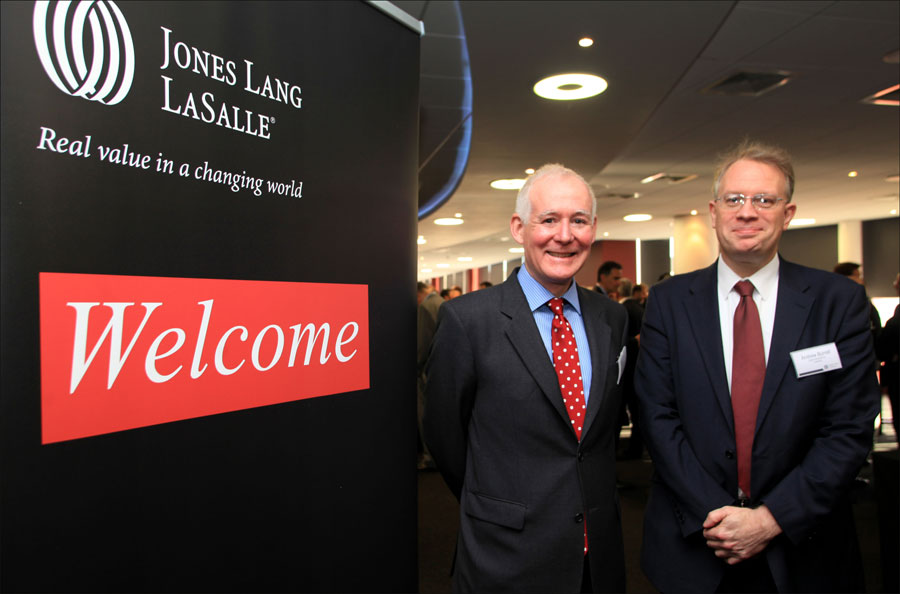This year’s South Coast Metropole Breakfast briefing was hosted for the first time at Southampton Football Stadium. Over 200 guests attended to get their copy of the latest property report, now in its 18th year, and learn about the key 2013 market headlines as well as hear our predictions for main property sectors going forward. In addition to the report guests received a cake to celebrate Jones Lang LaSalle Southampton’s office coming of age.
Michael Green, Lead Director from Jones Lang LaSalle’s Southampton office commented on some of the trends emerging in the property industry, both nationally and regionally whilst Andrew Burrell, head of forecasting, EMEA Research, provided a wider overview on the current economic situation across the globe and the drivers of both the international and regional economies over the next twelve months or so.
Michael Green said: “As it’s our birthday, let’s allow ourselves a moment to reflect and start by looking at where we were when we started these briefings back in 1996. The world then was just beginning to recover from the recession of 1991. Since then we have experienced a roller-coaster ride economically. Markets continued to rise right up until the dot.com bubble in 2000, and then again rose more or less continuously from 2002 until, as we all know, it all got a little silly, finally crashing in dramatic fashion after The Lehman Brothers collapsed in 2008.
“Since then, it has, on the whole been a pretty challenging time for everyone in the west, as we faced a massive debt crisis, a weak US economy and the prospects of years if not decades of zero growth and high inflation.
“But as we enter the final quarter of 2013, there are some real signs that things are beginning to look much better for all of us. We are certainly in a better place than we were 12 months ago, and a far better place than in 2011.The US Economy is improving, moving into a sustainable growth phase to such an extent that the Federal Reserve has announced an end to its asset purchase programme at the end of this year. However, as we all saw, this announcement caused a major wobble in other countries, showing just how jumpy the rest of the world still remains.
“The Eurozone remains a mess, but it does now look as if the crisis in containable. Eighteen months ago we were facing the very real threat of a break-up of the Eurozone, the streets of Athens were burning and in Spain more young people were out of work than working. Now it looks as if, after an incredibly painful period, it may just hold together.
Here in the UK there are very clear signs that the economy is beginning to move from a ‘rescue’ phase to a ‘recovery’ phase. GDP growth is likely to settle at around 1.0% this year, (this compares to World GDP projected to reach 2% this year and 3.8% in 2014).
“Both the consumer and services sector have rallied, with retail sales firm and new car sales buoyant. We expect to see a marked improvement as we move into 2014 led by an improvement in consumer sentiment (people are starting to buy stuff again) and a much more buoyant housing market.
“There are risk factors of course, and these come from several directions:- Externally the Eurozone remains a threat, and with elections in Germany later this year, there could be a change in sentiment that leaves Italy, Greece and Spain exposed, and consequently further uncertainty.
“Domestically, debt levels still remain too high and are not projected to get back to ‘normal’ levels until 2016. In the intervening period if one or more events cause a fall in confidence we could see consumers switch back from spending to debt repayment and finally the on-going fiscal austerity measures and inflation pressures could also provide a dampening effect on growth prospects in the UK.
“But generally speaking we appear to be looking at the prospect of unspectacular, modest growth in the UK over a 5 year time-span.
“We expect to see some modest rental growth in the UK, particularly in the industrial sector, but we expect yields to remain pretty flat (although reliably steady) for the retail, industrial and office sectors at least until 2017/18, a strong housing market and a return to capital investment.
“London will continue to lead the way, with foreign investment continuing to pour into the capital, particularly in the residential and office markets, where the city is still seen as a safe haven, both politically and economically, particularly from Far Eastern and Asian investors.
“Other parts of the south-east and south-west are also showing some signs of recovery, including here in the Metropole, and these markets are generally stronger than in the north, with the exception of some of the larger conurbations, such as Manchester and Birmingham.”
The morning concluded with a tour of St Mary’s Stadium for the guests.



















